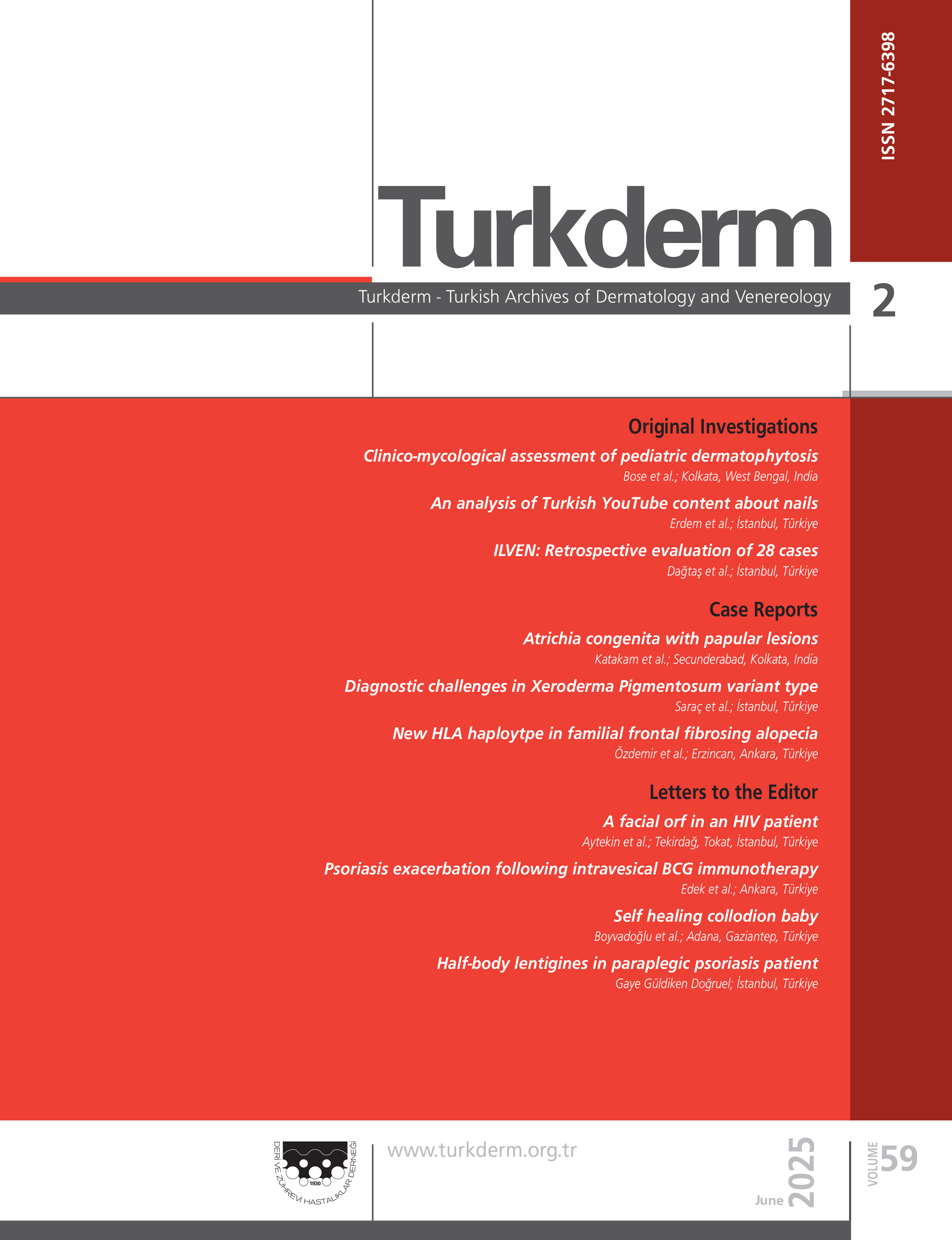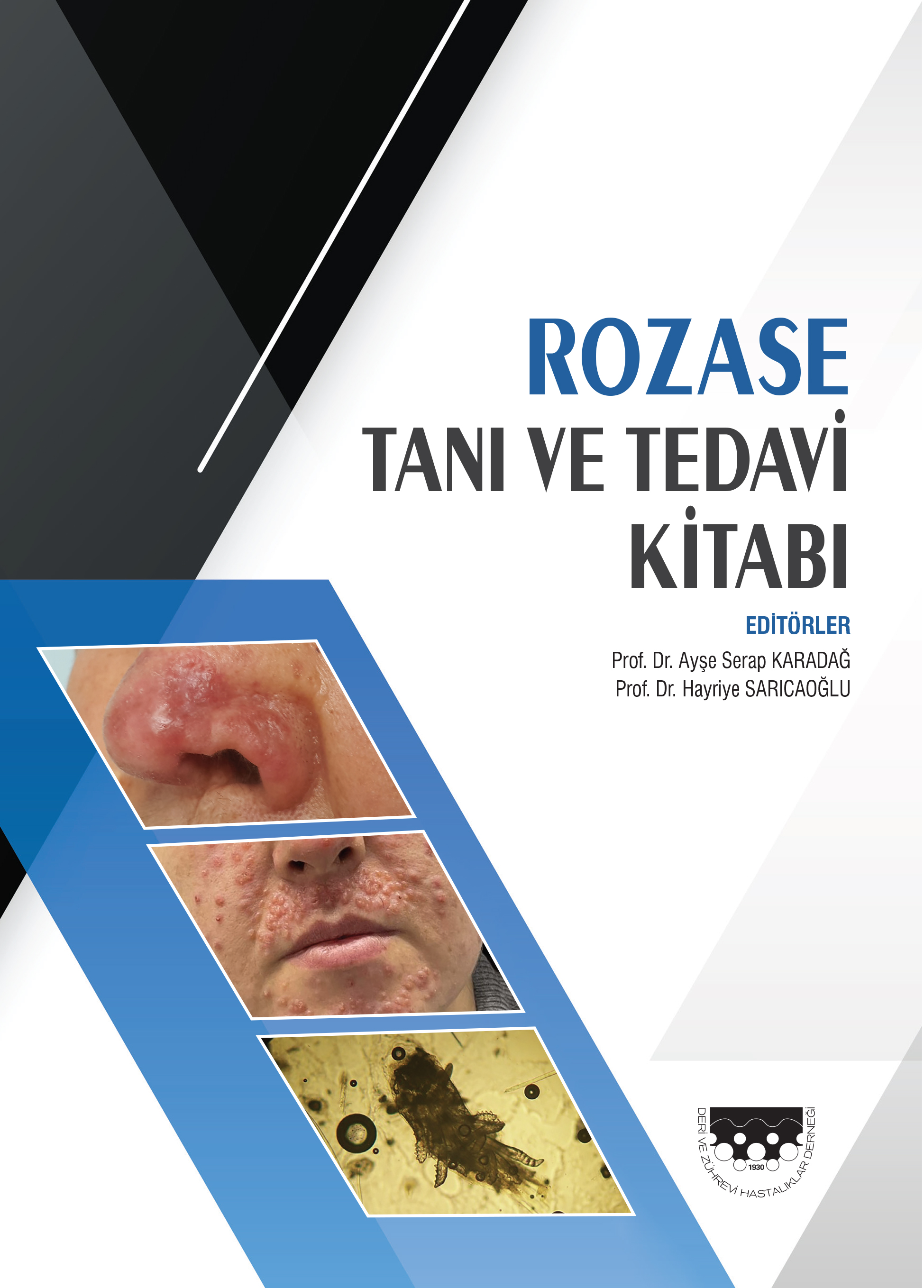Volume: 55 Issue: 3 - 2021
| 1. | Cover Pages I - VI |
| ORIGINAL INVESTIGATION | |
| 2. | Investigation of macrophage migration inhibitory factors and gene polymorphisms in patients with psoriasis Vildan Manav, Seval Doğruk Kaçar, Pınar Özuğuz, Saliha Handan Yıldız, Müjgan Özdemir Erdoğan, Tülay Köken doi: 10.4274/turkderm.galenos.2020.56873 Pages 102 - 107 Background and Design: Psoriasis is a multifactorial disease whose causal origin is unclear. Macrophage migration inhibitory factors (MIF) seem pivotal in inflammation and immune response in psoriasis pathogenesis. We aimed to investigate the serum MIF levels and MIF gene polymorphism (rs755622 and rs1007888) in patients with psoriasis. Materials and Methods: In this study, the association of serum MIF levels and MIF gene polymorphisms with psoriasis were investigated among 100 patients in Turkey. Genotyping was performed by real-time polymerase chain reaction. Serum MIF levels were evaluated by ELISA, and the results were presented in ng/mL. Results: The distribution of rs755622 genotype frequencies in the psoriasis group was: 75, 18, and 4 patients with CC, CG, and GG, respectively. The distribution of rs1007888 genotype frequencies in the psoriasis group was: 22, 48, and 26 patients with AA, AG, and GG, respectively. There was no statistically significant difference between the two groups. However, there was a statistically significant difference between the mean serum MIF levels of psoriasis patients (3.29 ng/mL) compared with the control group (1.08 ng/mL) (p<0.001). Conclusion: Significantly higher serum MIF levels were found in patients with psoriasis. However, there was no gene polymorphism association for genetic markers rs755622 or rs1007888 with psoriasis. Further studies in larger populations are warranted to elucidate the role of MIF and its clinical effects. |
| 3. | Double serum sampled glomerular filtration rate measurement with technetium-99m diethylenetriamine-penta acetate for evaluation of renal functions in patients with psoriasis vulgaris Rukiye Yasak Guner, Sibel Berksoy Hayta, Melih Akyol, Zekiye Hasbek, Sedat Özçelik, Meryem Timuçin doi: 10.4274/turkderm.galenos.2021.79577 Pages 108 - 112 Background and Design: Psoriasis is a common chronic inflammatory skin disease believed to affect renal functions. Glomerular filtration rate (GFR) is the most important indicator used to assess renal functions. The present study aims to measure the renal function of psoriasis patients via the technetium-99m diethylenetriamine pentaacetate (Tc-99m DTPA) method and compare the values obtained with those determined through indirect measurement methods, such as the modification of diet in renal disease (MDRD) and chronic kidney disease epidemiology collaboration (CKD-EPI), considering the effects of systemic treatments and comorbidities. Materials and Methods: Eighty-seven patients diagnosed with chronic plaque-type psoriasis vulgaris were included in this study. The patients demographic characteristics, disease duration, psoriasis area and severity index score, drugs received for psoriasis treatment, comorbidities, and drugs received for comorbidity treatment were noted. Estimated GFRs were also calculated using the MDRD and CKD-EPI formulas. Results: Tc-99m DTPA values were affected only by age. As the patient age increased, a significant decrease in GFR measured with Tc-99m DTPA (r=0.289, p<0.001) was observed. Conclusion: Psoriasis, comorbidities, and nephrotoxic drugs used for treatment did not affect renal functions. GFR measurements were affected only by age. |
| 4. | The real-life efficacy and safety of secukinumab therapy (150 and 300 mg) in patients with moderate-to-severe plaque psoriasis: A twelve week, single center, retrospective study İncilay Kalay Yıldızhan, Merve Aygün, Nihal Kundakçı doi: 10.4274/turkderm.galenos.2021.70446 Pages 113 - 118 Background and Design: Secukinumab is an effective treatment option in moderate-to-severe plaque type psoriasis. However, there are a few real-life data studies comparing the efficacy of 150 mg and 300 mg dosages. The aim of this study was to evaluate the efficacy and safety of secukinumab at 150 mg and 300 mg in clinical practice in chronic plaque type psoriasis patients attending our center. Materials and Methods: The medical records of 33 patients consecutively treated with secukinumab 150 mg or 300 mg for a minimum threemonth period were analyzed retrospectively. Treatment response was defined as the achievement of a minimum psoriasis area and severity index (PASI) 75 response at week 12. Results: Eighteen (55.5%) of the patients were men. The mean duration of the disease was 20±9.38 (1-40) years. Most (75.7%) patients had previously received at least one biological therapy. Seventeen patients were treated with 300 mg and 14 with 150 mg during the induction and maintenance periods. Two patients received induction therapy at 150 mg and maintenance therapy at 300 mg. At week 12, PASI 75, 90, and 100 responses were achieved in 78.8%, 66.7%, and 22.3% of patients, respectively. Treatment responses were similar between patients receiving 150 mg and 300 mg, and also between biologic naive and non-naive patients (p>0.05). Adverse events were observed in three patients, but these did not necessitate discontinuation of therapy. Conclusion: Secukinumab at doses of 150 mg and 300 mg is a fast-acting, effective and safe treatment option in patients with chronic plaque type psoriasis, both biologic naive and non-naive. |
| 5. | Factors in the etiopathogenesis of post-adolescent female acne Ezgi Özkur, Damla Demir, İlknur Kıvanç Altunay, Mustafa Demir, Oktay Tosun doi: 10.4274/turkderm.galenos.2021.04382 Pages 119 - 124 Background and Design: Post-adolescent acne has been defined as acne that persists or whose onset starts beyond the age of 25 years. The presence of hyperandrogenemia, polycystic ovary syndrome (PCOS), dyslipidemia, and insulin sensitivity play a role in etiopathogenesis of post-adolescent acne in women as shown in previous studies. This study was conducted to investigate these relationships. Materials and Methods: We included 45 female patients with post-adolescent acne and 30 age, sex, and body mass index-matched healthy controls. Demographic characteristics, clinical signs of hyperandrogenemia, pelvic ultrasound scan, and hormonal assessment including the [total testosterone (TT), sex hormone binding globulin (SHBG), dehydroepiandrosterone sulfate (DHEAS), follicle stimulating hormone (FSH), luteinizing hormone (LH), prolactin (PRL), estradiol (E2)] and fasting plasma glucose, and insulin and lipid levels were recorded. Results: Woman with post-adolescent acne had the marked presence of menstrual abnormalities (37.7%), hirsutism (13.3%), androgenetic alopecia (11.1%), metabolic syndrome (MS) (32.4%), and PCOS (22.2%). Pelvic ultrasound scans showed that 17.8% of the patients had polycystic ovaries. In addition, the percentage of current smokers was significantly higher in the patient group than the controls (p=0.001). TT and LH were significantly higher in post-adolescent acne patients than the controls (p=0.048, and p=0.012, respectively). No significant differences were observed between patients and controls in terms of SHBG, DHEAS, FSH, PRL, E2, and total cholesterol, low-density lipoprotein cholesterol, high-density lipoprotein cholesterol, and triglyceride levels. No correlations were observed between these parameters and the severity of acne. Conclusion: Although laboratory hormonal assessment showed no significant difference, post-adolescent acne patients had marked menstrual irregularities, polycystic ovaries, androgenetic alopecia, hirsutism, and MS. However, insulin resistance and dyslipidemia may not play a major role in the pathogenesis of post-adolescent female acne. |
| 6. | Secukinumab in psoriasis: A single-center experience Esra Ağaoğlu, Hilal Kaya Erdoğan, Ersoy Acer, Zeynep Nurhan Saraçoğlu, Muzaffer Bilgin doi: 10.4274/turkderm.galenos.2021.75046 Pages 125 - 129 Background and Design: Several randomized clinical trials demonstrated the safety and efficacy of secukinumab in the systemic treatment of moderate-severe psoriasis; however, real-life data is limited. Thus, this study aimed to assess the efficacy and safety of secukinumab in patients with psoriasis. Materials and Methods: In this study, 32 patients treated with secukinumab were retrospectively reviewed. The efficacy of secukinumab was evaluated as psoriasis area and severity index (PASI) 50, 75, and 90 response rates at 16., 24., and 36. weeks, respectively. Side effects of secukinumab treatment were recorded. Results: The mean PASI of 32 patients before treatment was 12.38±6.49, which decreased to 1.96, 1.85, and 3.01, after 16, 24, and 36 weeks, respectively. At 16 weeks of treatment, 83.3% of patients reached PASI 50, 70.0% had PASI 75, and 50.0% had PASI 90 response rates. At 16, 24, and 36 weeks, PASI 50, 75, and 90 responses were generally higher in patients naive to biologic than the non-naive; however, differences were not statistically significant (p>0.05). Secukinumab was discontinued in 7 (21.9%) patients during the treatment. Of the 7 patients, 5 (15.6%) patients failed to respond to secukinumab and 2 (6.2%) developed various side effects. Oral candidiasis was observed in 4 (12.5%) patients, which was the most common side effect of secukinumab treatment. Conclusion: Secukinumab is an effective and safe treatment option in patients with psoriasis. The secukinumab efficacy in clinical practice is higher in patients naive to biologic. |
| 7. | Prevalence and clinical spectrum of childhood leprosy in a tertiary care hospital in Kolar Naveena Gvl, Suresh Kumar Kuppuswamy, Rajashekar Talari Srinivas, Hanumanthayya Keloji doi: 10.4274/turkderm.galenos.2021.60490 Pages 130 - 134 Background and Design: Leprosy is a chronic granulomatous, infectious disease that primarily affects the skin and peripheral nerves. Leprosy in children is an indicator of active transmission in the community. This study aimed to analyze the prevalence and clinical spectrum of childhood leprosy and highlight the importance of examining close contacts and the impact of detection and treatment of leprosy in the community. Materials and Methods: This retrospective study included patients presenting to the dermatology department of a tertiary care hospital attached to a medical college during the years 2011-2019. Results: Two hundred and twenty-three patients with leprosy were analyzed, of which 201 were adults and 22 were children. Children constituted 9.87% of the patients (approx. one child with leprosy for every 10 adults with leprosy). Of 22 children with leprosy, 13 (59.09%) were boys and nine (40.90%) were girls, with a ratio of 1.4: 1. Twelve of twenty-two child patients (54.54%) had a single patch, while 10 of 22 (45.45%) had more than one skin lesion. Fourteen patients (63.63%) were diagnosed clinically with borderline tuberculoid (BT) leprosy, and six patients (27.27%) had borderline lepromatous leprosy. Of the fourteen patients with BT leprosy, 10 patients (71.4%) had a single lesion. Eleven patients (50%) were diagnosed with multibacillary leprosy, and eleven patients (50%) were diagnosed with paucibacillary leprosy. A clinicopathological correlation was noted in 16 patients (72.72%). Family contact was observed in four children with leprosy. Conclusion: A high proportion of childhood leprosy cases indicates active transmission and warrants awareness among the community members and healthcare workers in terms of early detection and treatment of childhood and adult leprosy. This helps in preventing transmission, development of grave deformities, and associated social stigma of leprosy among the community members. |
| CASE REPORT | |
| 8. | Annular lichenoid dermatitis of youth: A report of two cases and a review of the literature Mavişe Yüksel, Ali Balevi, Alkım Ünal Çakıter, Mustafa Özdemir, İlknur Türkmen, Cüyan Demirkesen doi: 10.4274/turkderm.galenos.2020.96562 Pages 135 - 139 Annular lichenoid dermatitis of youth is a rare chronic dermatosis with an unknown cause, affecting both genders at an equal frequency. It is clinically characterized by a hypopigmented center and an erythematous border or hyperpigmented annular patches or plaques. The differential diagnosis includes annular dermatoses, such as tinea, erythema annulare centrifugum, erythema chronicum migrans, morphea, and mycosis fungoides. In this case report, we examined the clinical and histopathological features of two male patients aged 9 and 12 years with annular lichenoid dermatitis and presented their 3-year follow-up data while also reviewing the cases reported in the literature. |
| 9. | A case of atrophic dermatofibroma Aysun Şikar Aktürk, Dilek Bayramgürler, Ömür Kocaoğlu, Gupse Turan doi: 10.4274/turkderm.galenos.2020.37097 Pages 140 - 142 Dermatofibromas are benign tumors caused by fibroblasts and histiocytes, which are quite common in middle-aged adults. It is characterized by hard, single or multiple, papule, plaque or nodul-shaped lesions that are localized to the lower extremity. Many clinical and pathological variants of dermatofibroma have been identified. One of these variants is atrophic dermatofibroma. Atrophic dermatofibroma is generally seen in middle-aged women as lesions that collapse inward, showing placement on the upper part of the body and arms. It can be confused with morphea, atrophoderma, neurofibroma, localized lipoatrophy, healing panniculitis lesions, anetoderma, steroid atrophy, and basal cell carcinoma. The definitive diagnosis is made by histopathological examination as well as clinical findings. Positive immunohistochemical staining for factor XIIIa, as well as a negative reaction for CD34, support a diagnosis of dermatofibroma. A 38-year-old woman diagnosed with atrophic dermatofibroma is presented here. |
| 10. | Coexistence of Touraine-Solente-Gole syndrome and type 1 neurofibromatosis: A case report Selma Korkmaz, Hakan Korkmaz, İjlal Erturan, Havva Hilal Ayvaz, Kuyaş Hekimler Öztürk, Mehmet Yıldırım doi: 10.4274/turkderm.galenos.2021.42708 Pages 143 - 146 Pachydermoperiostosis is a rare syndrome that affects the skin and skeletal system. Mutations in the gene encoding hydroxyprostaglandin dehydrogenase (HPGD) are thought to play a role in disease etiopathogenesis. The disease is typically seen in males and is characterized by skin thickening (pachydermia), clubbing, and subperiosteal new bone formation. A 57-year-old male patient was admitted to our clinic with growth complaints of growth his hands, feet, and face. He had a prominence of forehead lines and fist-sized round bulges on his torso and face. The patients history also indicated that he was clinically followed up for neurofibromatosis 1 (NF1). No mutations in the HPGD and SLCO2A1 genes were identified. This is the first case in the literature that reviews pachydermoperiostosis and NF together. The coexistence of skin findings of two different diseases in the same patient indicates that both diseases may be related to different genetic pathways. |
| 11. | Pyogenic granuloma-like Kaposi sarcoma: A case report with dermatoscopical and histopathological characteristics Hatice Gamze Demirdağ, Emine Benzer, Burcu Tuğrul doi: 10.4274/turkderm.galenos.2021.08931 Pages 147 - 149 Pyogenic granuloma-like Kaposi sarcoma (PG-like KS) is an uncommon clinicopathologic variant of KS. This is a challenging entity to diagnose because it combines the clinical and histopathological characteristics of both PG and KS. Herein, we present a case of PG-like nodular-type KS with dermatoscopical and histopathological characteristics. |
| 12. | Herpes zoster case with extremity involvement after chickenpox infection in a healthy infant Gözde Emel Gökçek, Emine Çölgeçen doi: 10.4274/turkderm.galenos.2021.45381 Pages 150 - 152 Herpes zoster is a dermatomal condition characterized by painful vesiculopapules on an erythematous background, resulting from the reactivation of varicella-zoster virus (VZV) hidden in the dorsal root ganglia. Although it is more common in older and immunosuppressed people, it can be seen at any age. It very rarely occurs in the infantile period, and in healthy infants, herpes zoster usually develops after intrauterine exposure to the virus. Herein, we present the case of a 12-month-old girl who developed a rare form of herpes zoster on the extremities after postnatal VZV exposure. |
| TIPS FOR INTERVENTIONAL DERMATOLOGY | |
| 13. | An island pedicle advancement flap effective technique for the repair of nasolabial defects Leyla Huseynova, Gonca Elçin doi: 10.4274/turkderm.galenos.2021.24478 Pages 153 - 155 |























